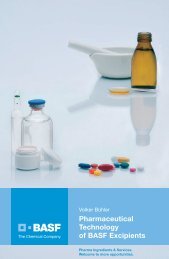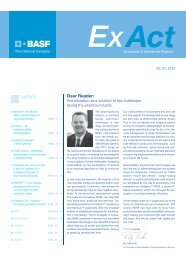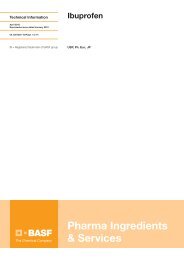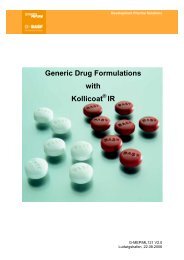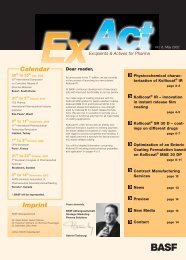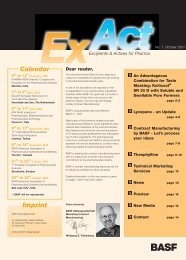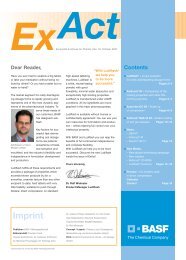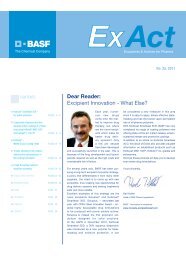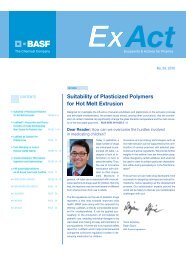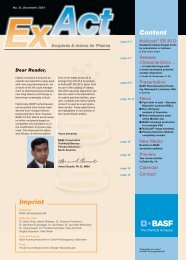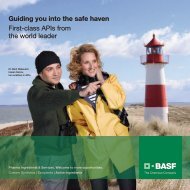Dear Reader: Innovations across the entire package - Pharma ...
Dear Reader: Innovations across the entire package - Pharma ...
Dear Reader: Innovations across the entire package - Pharma ...
Create successful ePaper yourself
Turn your PDF publications into a flip-book with our unique Google optimized e-Paper software.
Excipients & Actives for <strong>Pharma</strong><br />
No. 26, 2011<br />
BREAKING NEWS<br />
Andreas Gryczke, BASF’s expert for hot-melt extrusion, will appear<br />
at this year's AAPS with posters covering various aspects of this<br />
innovative production technology.<br />
The use of melt extrusion processes in <strong>the</strong><br />
pharmaceutical industry is a highly promising<br />
approach to <strong>the</strong> various challenges presented<br />
by current and future formulations.<br />
Melt extrusion is still a recent development in<br />
<strong>the</strong> pharmaceutical industry. So far, academia<br />
and industry focused on getting to grips with<br />
<strong>the</strong> basics of hot-melt extrusion. However, it<br />
has been established that this new technology<br />
has great potential for <strong>the</strong> formulation of drugs<br />
containing poorly soluble or poorly permeable<br />
active ingredients. The first commercial formulations<br />
confirm this.<br />
Since <strong>the</strong>re is an increasing desire on <strong>the</strong> part<br />
of <strong>the</strong> industry to make better use of this technology<br />
in development and manufacturing, <strong>the</strong><br />
proposed sessions aim to provide ideas and<br />
Posters at AAPS 2011 presented by<br />
Andreas Gryczke, featuring <strong>the</strong> hot-melt<br />
extrusion technique<br />
• Small-scale miscibility screening for<br />
solid dispersions in tablets prepared by<br />
injection molding: a study on itraconazole<br />
in combination with Soluplus ® .<br />
• In-line monitoring of a hot-melt extrusion<br />
process using near-infrared spectros<br />
copy.<br />
• Investigation of tablets made by injection<br />
molding: R&D-stage manufacturing and<br />
characterization of <strong>the</strong>ophylline-PEO<br />
tablets.<br />
guidance on <strong>the</strong> various aspects of implementation.<br />
These lectures are different from o<strong>the</strong>r<br />
HME sessions, which have focused on educating<br />
scientists on <strong>the</strong> basics. Instead, <strong>the</strong> proposed<br />
sessions will deal with <strong>the</strong> process itself,<br />
its implementation and its characterization. The<br />
goal is to provide <strong>the</strong> industry and researchers<br />
with insights into <strong>the</strong> process, its advantages<br />
and disadvantages and to offer guidance on<br />
how to mitigate problems using a risk assessment<br />
approach when implementing this exciting,<br />
pioneering technology.<br />
Kollicoat ® IR and Kollicoat ®<br />
SR 30 D to be published in <strong>the</strong><br />
Handbook of <strong>Pharma</strong>ceutical<br />
Excipients<br />
Kollicoat IR approved by Australian Department<br />
of Health and Ageing<br />
It has been announced that <strong>the</strong> two coating polymers<br />
Kollicoat IR (ethylene glycol and vinyl alcohol<br />
grafted copolymer) and Kollicoat SR 30 D<br />
(polyvinyl acetate dispersion) are to be included<br />
in <strong>the</strong> Handbook of <strong>Pharma</strong>ceutical Excipients.<br />
Both polymers will appear in <strong>the</strong> online version<br />
of <strong>the</strong> handbook as of August 2011, and in <strong>the</strong><br />
upcoming 7th edition of <strong>the</strong> print version. Toge<strong>the</strong>r<br />
with <strong>the</strong> monographs in <strong>the</strong> US and <strong>the</strong><br />
EU pharmacopoeias, <strong>the</strong> inclusion of Kollicoat IR<br />
and Kollicoat SR 30 D underlines BASF’s continuous<br />
efforts to bring safe and innovative coating<br />
excipients to its customers – helping <strong>the</strong>m <strong>the</strong>m<br />
tackle today’s and future formulation challenges<br />
successfully.<br />
Kollicoat IR, BASF’s 3rd generation instant release<br />
coating, has already been approved by <strong>the</strong><br />
health authorities in Europe, Canada and Japan.<br />
We are pleased to inform you that Kollicoat IR<br />
is now also approved by <strong>the</strong> Therapeutic Goods<br />
Administration (TGA) of <strong>the</strong> Australian Department<br />
of Health and Ageing.<br />
According to <strong>the</strong> TGA, Kollicoat IR (Polyethylene<br />
glycol-polyvinyl alcohol graft copolymer) is considered<br />
to be safe for use as an excipient in oral<br />
medicines at concentrations of less than 5% in<br />
<strong>the</strong> finished product.<br />
Kollicoat IR is currently monographed in <strong>the</strong> following<br />
pharmacopoeias:<br />
• Ph.Eur monograph – Macrogol poly(vinyl alcohol)<br />
grafted copolymer<br />
• USP-NF monograph – Ethylene Glycol and<br />
Vinyl Alcohol Graft Copolymer<br />
Self-affirmed GRAS status is expected end of<br />
2011; listing in <strong>the</strong> FDA’s Inactive Ingredients<br />
database (IIG) in early 2012.<br />
Page 19



